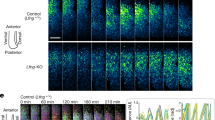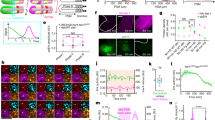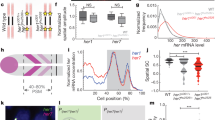Abstract
Periodic somite segmentation in vertebrate embryos is controlled by the ‘segmentation clock’, which consists of numerous cellular oscillators. Although the properties of a single oscillator, driven by a hairy negative-feedback loop, have been investigated, the system-level properties of the segmentation clock remain largely unknown. To explore these characteristics, we have examined the response of a normally oscillating clock in zebrafish to experimental stimuli using in vivo mosaic experiments and mathematical simulation. We demonstrate that the segmentation clock behaves as a coupled oscillator, by showing that Notch-dependent intercellular communication, the activity of which is regulated by the internal hairy oscillator, couples neighbouring cells to facilitate synchronized oscillation. Furthermore, the oscillation phase of individual oscillators fluctuates due to developmental noise such as stochastic gene expression and active cell proliferation. The intercellular coupling was found to have a crucial role in minimizing the effects of this noise to maintain coherent oscillation.
This is a preview of subscription content, access via your institution
Access options
Subscribe to this journal
Receive 51 print issues and online access
$199.00 per year
only $3.90 per issue
Buy this article
- Purchase on Springer Link
- Instant access to full article PDF
Prices may be subject to local taxes which are calculated during checkout




Similar content being viewed by others
References
Winfree, A. T. Biological rhythms and the behavior of populations of coupled oscillators. J. Theor. Biol. 16, 15–42 (1967)
Winfree, A. T. The Geometry of Biological Time (Springer, New York, 2000)
Palmeirim, I., Henrique, D., Ish-Horowicz, D. & Pourquié, O. Avian hairy gene expression identifies a molecular clock linked to vertebrate segmentation and somitogenesis. Cell 91, 639–648 (1997)
Pourquié, O. The segmentation clock: converting embryonic time into spatial pattern. Science 301, 328–330 (2003)
Saga, Y. & Takeda, H. The making of the somite: molecular events in vertebrate segmentation. Nature Rev. Genet. 2, 835–845 (2001)
Dale, J. K. et al. Periodic notch inhibition by lunatic fringe underlies the chick segmentation clock. Nature 421, 275–278 (2003)
Cooke, J. Control of somite number during morphogenesis of a vertebrate, Xenopus laevis. Nature 254, 196–199 (1975)
Cooke, J. & Zeeman, E. C. A clock and wavefront model for control of the number of repeated structures during animal morphogenesis. J. Theor. Biol. 58, 455–476 (1976)
Cooke, J. A gene that resuscitates a theory—somitogenesis and a molecular oscillator. Trends Genet. 14, 85–88 (1998)
Holley, S. A., Julich, D., Rauch, G. J., Geisler, R. & Nusslein-Volhard, C. her1 and the notch pathway function within the oscillator mechanism that regulates zebrafish somitogenesis. Development 129, 1175–1183 (2002)
Hirata, H. et al. Oscillatory expression of the bHLH factor Hes1 regulated by a negative feedback loop. Science 298, 840–843 (2002)
Bessho, Y., Hirata, H., Masamizu, Y. & Kageyama, R. Periodic repression by the bHLH factor Hes7 is an essential mechanism for the somite segmentation clock. Genes Dev. 17, 1451–1456 (2003)
Henry, C. A. et al. Two linked hairy/Enhancer of split-related zebrafish genes, her1 and her7, function together to refine alternating somite boundaries. Development 129, 3693–3704 (2002)
Oates, A. C. & Ho, R. K. Hairy/E(spl)-related (Her) genes are central components of the segmentation oscillator and display redundancy with the Delta/Notch signaling pathway in the formation of anterior segmental boundaries in the zebrafish. Development 129, 2929–2946 (2002)
Jiang, Y. J. et al. Notch signalling and the synchronization of the somite segmentation clock. Nature 408, 475–479 (2000)
Lewis, J. Autoinhibition with transcriptional delay: a simple mechanism for the zebrafish somitogenesis oscillator. Curr. Biol. 13, 1398–1408 (2003)
Holley, S. A., Geisler, R. & Nusslein-Volhard, C. Control of her1 expression during zebrafish somitogenesis by a delta-dependent oscillator and an independent wave-front activity. Genes Dev. 14, 1678–1690 (2000)
Sawada, A. et al. Fgf/MAPK signalling is a crucial positional cue in somite boundary formation. Development 128, 4873–4880 (2001)
Dubrulle, J., McGrew, M. J. & Pourquié, O. FGF signaling controls somite boundary position and regulates segmentation clock control of spatiotemporal Hox gene activation. Cell 106, 219–232 (2001)
McAdams, H. H. & Arkin, A. Stochastic mechanisms in gene expression. Proc. Natl Acad. Sci. USA 94, 814–819 (1997)
Shav-Tal, Y. et al. Dynamics of single mRNPs in nuclei of living cells. Science 304, 1797–1800 (2004)
Blake, W. J., Kærn, M., Cantor, C. R. & Collins, J. J. Noise in eukaryotic gene expression. Nature 422, 633–637 (2003)
Prescott, D. M. & Bender, M. A. Synthesis of RNA and protein during mitosis in mammalian tissue culture cells. Exp. Cell Res. 26, 260–268 (1962)
Nagoshi, E. et al. Circadian gene expression in individual fibroblasts: cell-autonomous and self-sustained oscillators pass time to daughter cells. Cell 119, 693–705 (2004)
Welsh, D. K., Yoo, S. H., Liu, A. C., Takahashi, J. S. & Kay, S. A. Bioluminescence imaging of individual fibroblasts reveals persistent, independently phased circadian rhythms of clock gene expression. Curr. Biol. 14, 2289–2295 (2004)
Ueda, H. R., Hirose, K. & Iino, M. Intercellular coupling mechanism for synchronized and noise-resistant circadian oscillators. J. Theor. Biol. 216, 501–512 (2002)
Rida, P. C., Le Minh, N. & Jiang, Y. J. A Notch feeling of somite segmentation and beyond. Dev. Biol. 265, 2–22 (2004)
Evrard, Y. A., Lun, Y., Aulehla, A., Gan, L. & Johnson, R. L. lunatic fringe is an essential mediator of somite segmentation and patterning. Nature 394, 377–381 (1998)
Zhang, N. & Gridley, T. Defects in somite formation in lunatic fringe-deficient mice. Nature 394, 374–377 (1998)
Aulehla, A. et al. Wnt3a plays a major role in the segmentation clock controlling somitogenesis. Dev. Cell 4, 395–406 (2003)
Ma'ayan, A. et al. Formation of regulatory patterns during signal propagation in a mammalian cellular network. Science 309, 1078–1083 (2005)
Brandman, O., Ferrell, J. E. Jr, Li, R. & Meyer, T. Interlinked fast and slow positive feedback loops drive reliable cell decisions. Science 310, 496–498 (2005)
Bornholdt, S. Systems biology. Less is more in modeling large genetic networks. Science 310, 449–451 (2005)
Waddington, C. Canalization of development and the inheritance of acquired characters. Nature 150, 563–565 (1942)
Houchmandzadeh, B., Wieschaus, E. & Leibler, S. Establishment of developmental precision and proportions in the early Drosophila embryo. Nature 415, 798–802 (2002)
Lucchetta, E. M., Lee, J. H., Fu, L. A., Patel, N. H. & Ismagilov, R. F. Dynamics of Drosophila embryonic patterning network perturbed in space and time using microfluidics. Nature 434, 1134–1138 (2005)
Freeman, M. Feedback control of intercellular signalling in development. Nature 408, 313–319 (2000)
Eldar, A. et al. Robustness of the BMP morphogen gradient in Drosophila embryonic patterning. Nature 419, 304–308 (2002)
Hall, B. K. & Olson, W. M. Keywords and Concepts in Evolutionary Developmental Biology (Harvard Univ. Press, Cambridge, Massachusetts, 2003)
von Dassow, G., Meir, E., Munro, E. M. & Odell, G. M. The segment polarity network is a robust developmental module. Nature 406, 188–192 (2000)
Ingolia, N. T. Topology and robustness in the Drosophila segment polarity network. PLoS Biol. 2, e123 (2004)
Kosman, D. et al. Multiplex detection of RNA expression in Drosophila embryos. Science 305, 846 (2004)
Julich, D. et al. beamter/deltaC and the role of Notch ligands in the zebrafish somite segmentation, hindbrain neurogenesis and hypochord differentiation. Dev. Biol. 286, 391–404 (2005)
Hirata, H. et al. Instability of Hes7 protein is crucial for the somite segmentation clock. Nature Genet. 36, 750–754 (2004)
Acknowledgements
We thank T. Fujimori for providing human histone 2B–EGFP cDNA; D. Tautz for the technical advice regarding the synthesis of intronic probes for her1; T. Tomita and T. Iwatsubo for their gift of DAPT; and Y. J. Jiang for Notch1a mutant (desth35b). We also thank H. Ueda, T. Uemura, M. Takeichi, A. Takamatsu and J. Lewis for their advice and for critical reading of the manuscript. This work was supported by a postdoctoral fellowship and in part by Grants-in-Aid for Scientific Research Priority Area Genome Science and Organized Research Combination System, both of which are from the Ministry of Education, Culture, Sports, Science and Technology of Japan.
Author information
Authors and Affiliations
Corresponding authors
Ethics declarations
Competing interests
Reprints and permissions information is available at npg.nature.com/reprintsandpermissions. The authors declare no competing financial interests.
Supplementary information
Supplementary Notes 1
Description of her1 and deltaC oscillation with Supplementary Figure 1–2. (DOC 1013 kb)
Supplementary Notes 2
Description of clock & wavefront model and segment-shift phenotype with Supplementary Figure 3–5. (DOC 458 kb)
Supplementary Notes 3
Description of mathematical simulations with Supplementary Figure 6–9. (DOC 627 kb)
Supplementary Figure 10
Randomized sub-cellular localization of her1 transcripts (green) in the posterior PSM of DAPT-treated embryo. Nuclear- or cytoplasmic-her1 transcripts are indicated by arrowheads and arrows, respectively. Magenta indicates nuclei. Bar, 20mm. (JPG 145 kb)
Supplementary Movie 1
This movie is a source of Supplementary Figure 6 showing the simulated effect of the actively signalling cell on the synchronized oscillation. (MOV 178 kb)
Supplementary Movie 2
This movie is a source of Figure 3a–b showing dorsal view of a normal PSM expressing Histone2B–GFP. Pseudo-colour labelled nuclei indicate cells which have experienced mitosis in right side of the posterior PSM during one cycle of oscillation (from 8-somite to 9-somite stage). Images were acquired at every minute for 30 minutes. (MOV 5123 kb)
Supplementary Movie 3
This movie is a source of Figure 8 showing the phase synchronization in linearly aligned 15 cells. One of transplanted cells (delayed by 1/4-cycle) is indicated by magenta. (MOV 264 kb)
Supplementary Movie 4
Schematic representation of the clock & wavefront model. Clock oscillation in the entire PSM and regressing wavefront are indicated by green and magenta, respectively. Oscillation phase of the clock is fixed at the time of interaction with the wavefront, eventually leaving segmental pattern of the somite. Anterior to the top. (MOV 679 kb)
Supplementary Movie 5
Segment-shift phenotype caused by the accelerated oscillation of the segmentation clock. The segmentation clock with higher frequency (blue) encounters the wavefront more anterior region, leaving smaller segments compared to normal condition. (MOV 133 kb)
Supplementary Table 1
Mitotic activity in the posterior PSM of normal, DMSO or DAPT-treated embryos at 8- to 9-somite stage. (DOC 30 kb)
Supplementary Methods
This file contains additional details on the methods used in this study. (DOC 26 kb)
Supplementary References
References in Supplementary Notes 1–3 and Supplementary Methods. (DOC 27 kb)
Rights and permissions
About this article
Cite this article
Horikawa, K., Ishimatsu, K., Yoshimoto, E. et al. Noise-resistant and synchronized oscillation of the segmentation clock. Nature 441, 719–723 (2006). https://doi.org/10.1038/nature04861
Received:
Accepted:
Issue Date:
DOI: https://doi.org/10.1038/nature04861
This article is cited by
-
A bioelectrical phase transition patterns the first vertebrate heartbeats
Nature (2023)
-
Synchronization of gene expression across eukaryotic communities through chemical rhythms
Nature Communications (2021)
-
Imaging and manipulating the segmentation clock
Cellular and Molecular Life Sciences (2021)
-
JAK/STAT guarantees robust neural stem cell differentiation by shutting off biological noise
Scientific Reports (2018)
-
Time-lapse observation of stepwise regression of Erk activity in zebrafish presomitic mesoderm
Scientific Reports (2018)
Comments
By submitting a comment you agree to abide by our Terms and Community Guidelines. If you find something abusive or that does not comply with our terms or guidelines please flag it as inappropriate.



